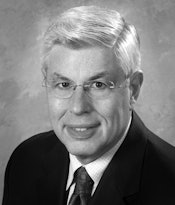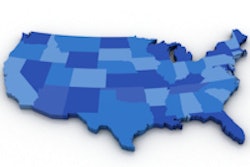
The U.S. radiology job market in 2014 appears to be flat, with 1,114 new positions compared to last year's 1,069, according to the third annual workforce survey by the ACR's Commission on Human Resources. The survey results were published online in the Journal of the American College of Radiology.
On top of the job news, the retirement plans of older radiologists and economic forces sparked by the Affordable Care Act (ACA) are market wild cards. Therefore, radiologists seeking employment would do well to be adaptable, wrote lead author Dr. Edward Bluth, of the Ochsner Clinic Foundation in New Orleans, and colleagues.
"In this tight job market, radiologists must be flexible and open to all options for professional employment," the team wrote.
Survey of practice leaders
 Dr. Edward Bluth from the Ochsner Clinic Foundation.
Dr. Edward Bluth from the Ochsner Clinic Foundation.Bluth and colleagues used the Practice of Radiology Environment Database (PRED) to identify 1,936 radiology practice leaders for their survey. Of these, 426 responded, for a rate of 22%; the responses cover practices representing 10,845 radiologists, or 35% of all practicing radiologists in the U.S. (JACR, August 12, 2014).
The survey asked participants to report the number of radiologists currently employed in their practice, the number hired in 2013, and the number they plan to hire in 2014 and 2017. It was sent out via email in January 2014; final data were received by March. The survey asked respondents to describe their organization type and to divide their departments between general radiology physicians and those hired to serve mainly as subspecialists.
Subspecialists rule
Bluth's team found that 82% of survey respondents were subspecialists, and the most common subspecialty areas were body imaging (12%), general interventional radiology (10.9%), and neuroradiology (10.3%). Also, in terms of subspecialty, the most significant change was an increase in radiologists focusing on informatics, moving from 0.40% in 2013 to 3.7%.
The percentage of survey participants across various geographic regions was similar to the overall makeup of ACR members. However, compared with last year's survey, there were more radiologists practicing in the West (25%), in the South (23%), in New England (16%), and in the Southwest (11%). The number of radiologists practicing in the Midwest (16%) and the Mid-Atlantic (9%) decreased, compared with 2013.
| Radiologist employment by practice type | ||
| Practice type | 2013 | 2014 |
| Private group | 54% | 53% |
| Academic university | 19% | 21% |
| Academic clinic | 14% | 8% |
| Hospital employee | 10% | 16% |
| Corporate employee | 1% | 2% |
| Veterans Affairs/military | 1% | 1% |
In this year's survey, the most growth in an age-range category was for radiologists between 35 and 45; 33% of the workforce consisted of radiologists in this age group, compared with 29% last year. In the remaining categories for this year, 7% were older than age 65, 21% were between 56 and 65, 31% were between 46 and 55, and 8% were younger than 35.
This year's survey also illuminated how many radiologists work full time (87%) versus part time (13%). The three most common part-time specialties were general radiology (28%), breast imaging (15%), and body imaging (12%).
Survey data from 2013 suggested that 1,526 radiologists would be hired, but only 1,069 were actually hired last year -- fewer than in 2011 or 2012 -- with general radiologists making up the majority at 16%, the authors wrote.
The bottom line?
Bluth and colleagues predict 1,114 new hires for 2014, with the largest numbers in breast imaging (14%), general interventional radiology (12%), neuroradiology (10%), and general radiology (10%). They also project there will be 1,131 new hires in 2017. Most job opportunities will be in private practice, followed by academic universities; in terms of geographic area, more jobs will be available in the Midwest, while the least availability will be in the Mid-Atlantic region.
But radiologists seeking to enter the market should be aware that their elders' retirement decisions could dramatically affect job availability, according to the authors. More than 6,400 radiologists are between 56 and 65, while 2,200 are older than 65. On the other side, new imaging modalities such as CT screening for lung cancer and the potential increase in healthcare coverage due to the ACA could boost the need for radiologists.
"Although the projections for job openings based on immediate needs appear to be flat, the job picture may change dramatically in the future," Bluth's team wrote.




















